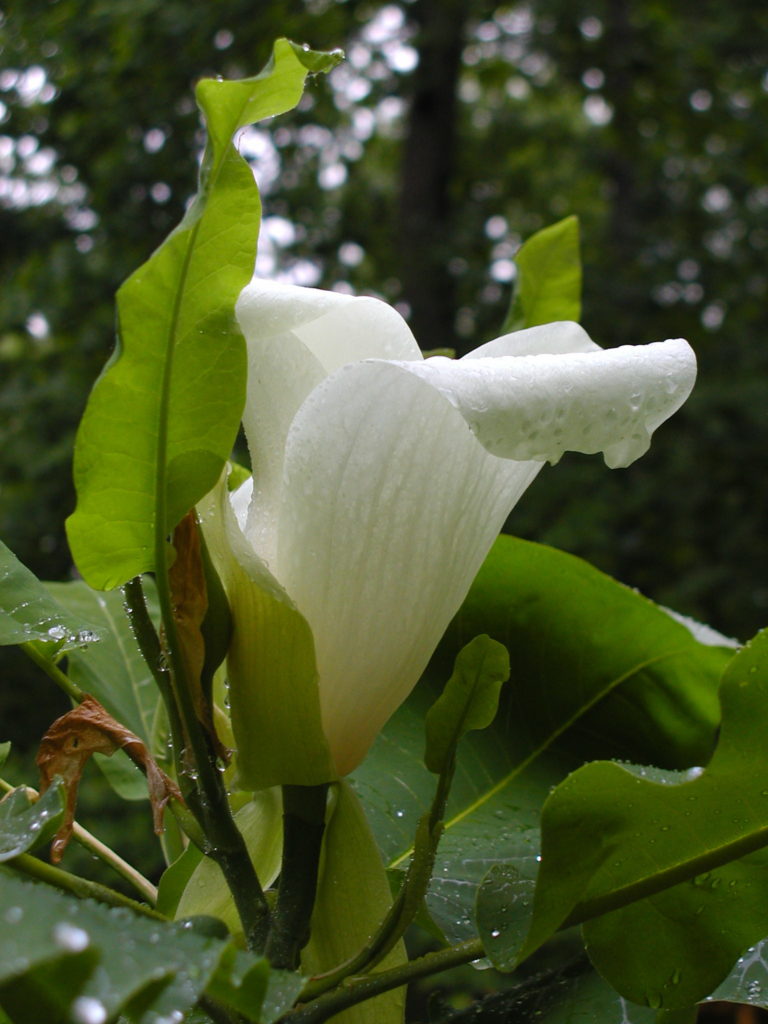Ashe’s Magnolia is a greatly underused, rare in cultivation, extremely ornamental small tree endemic to mixed hardwood forests and ravine slopes in a few counties in the “armpit” or panhandle of Florida. It is easily recognized by it’s very large leaf size, one to two feet long by six inches to a foot across, together with its small overall size, 20-25 feet. The numerous saucer-shaped, bright white flowers, with purple spots at the interior base of the petals, are correspondingly large – ten to twelve inches across – and are sweetly scented. This species flowers very early — we have seen it flower in a 1-gallon pot! — so the beautiful flowers are easily observed at eye-height, unlike its very tall cousins such as M.macrophylla and M. tripetela. (Some botanists classify this plant as Magnolia macrophylla subsp. ashei.) The magnificent flowers are followed by red to purple cone-like fruits. Magnolia ashei does not get particularly tall, but requires a good bit of lateral space for maximal show. This is a fantastic small, ornamental tree for our area. It has been named the 2017 plant of the year by the Garden Club of America.
NURSERY HOURS
Wednesday: 10-4 Thursday: 10-6 Friday-Saturday: 10-4 Sunday: 12-4
Magnolia ashei

Key Info
Scientific Name: Magnolia ashei Weath.
Common Names: Ashe's Magnolia, Deciduous Magnolia, Dwarf Bigleaf Magnolia
Family Names: Magnoliaceae
Plant Type: Tree / Shrub
Leaf Retention: Evergreen in southern parts of its range
Flower Color: Creamy white
Special Characteristics: Tolerates heat and humidity, Reported to be deer resistant., Showy fruit, Fragrant flowers
Additional Info
Habit: Small tree with broad, round crown, with crooked and wide-reaching branches.
Height: 12' to 25'
Spread: 12' to 25'
Soil Conditions: Moist well drained, acid to circumneutral pH, organic sandy, loamy, clay.
Leaves: Alternate, simple, entire leaves up to 2' long and up to 1' wide, with pinnate venation, ovate, wider near the tip than at the stem, green on the upper surface and whitish beneath.
Flowers (or reproductive structures: Perfect, creamy white blossoms, with purplish stains at the bases of the petals, grow at the end of woody stems, pointed upward. They are fragrant, vase-shaped, opening out flat as they mature. Each blossom has 6-8 petals, up to 6 inches long and about half as wide, and pointed at the tip. Flowers begin blooming when the leaves are about half grown and continue for several weeks in May.
Fruit: The pistil forms a fleshy (later woody), oval, seed-bearing, cone-like fruit which enlarges as it matures, 2-4 inches long and about 2 inches in diameter, with many red seeds attached to the cone by slender threads. Matures in fall.
Natural Distribution: Within its limited geographic range in the panhandle of Florida, Ashe's Magnolia has a spotty distribution in mixed hardwood forests, on ravine slopes, steepheads and bluffs.
USDA Hardiness Zone: 6 to 9
USDA Wetland Indicator Status in NC: FACU
Pollination: Magnolia is an ancient genus. Appearing before bees did, the flowers are usually pollinated by beetles. Today, bees are attracted to Magnolia flowers but generally they are too late to do the pollinating.
Wildlife Connections: Attracts bees, butterflies, flies, stinkbugs, leafhoppers and other insects which consume secretions in the flowers in addition to the pollinating beetles.
Propagation: From seeds.
